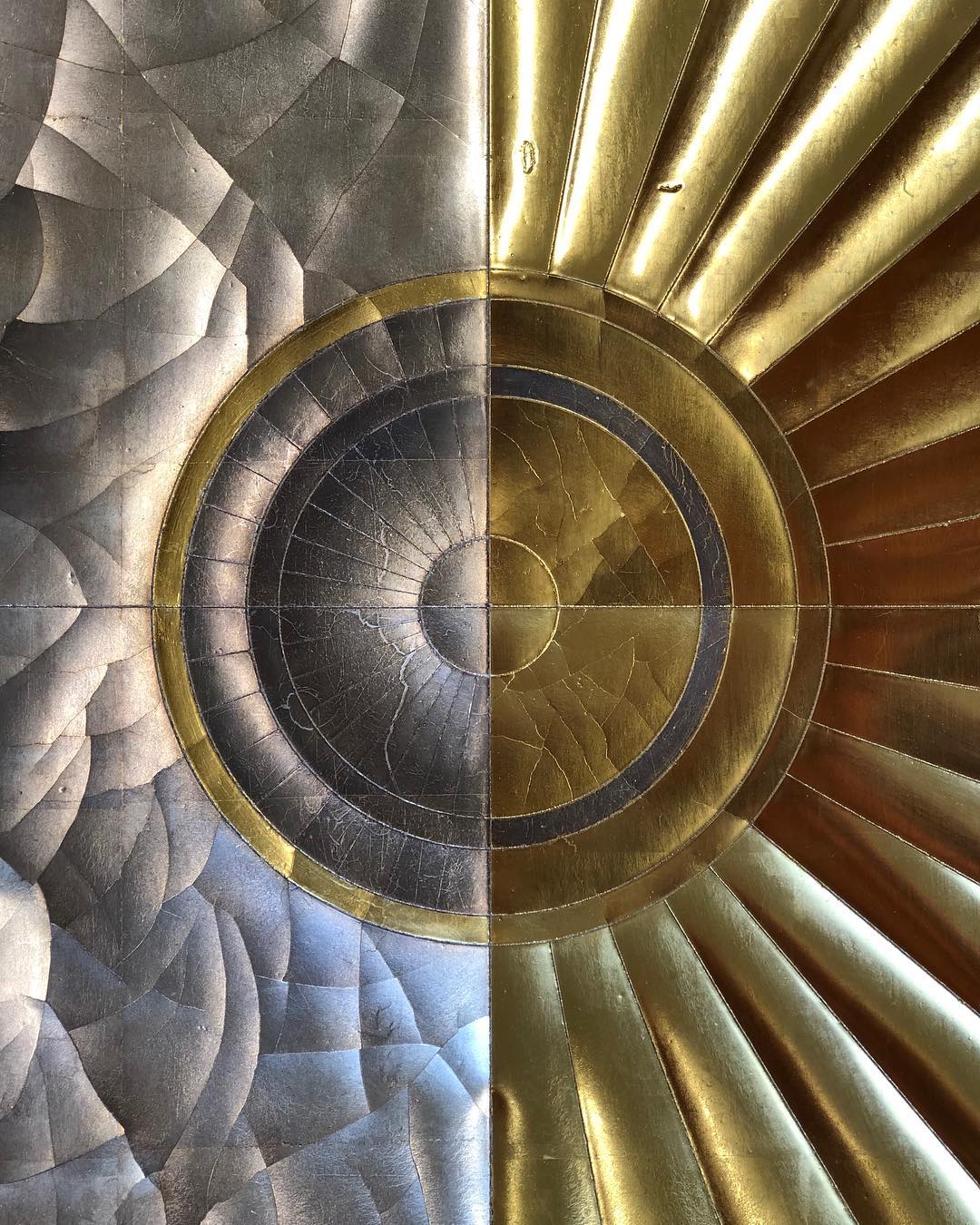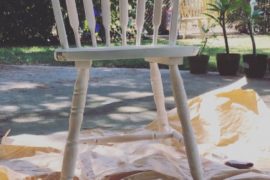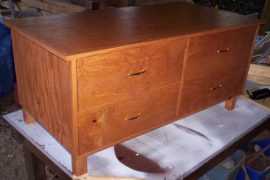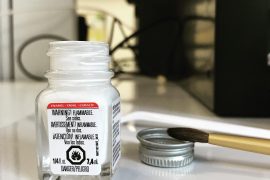The treatment process should not be attempted until the piece of furniture has been through a thorough cleaning and washing processes and allowed to dry completely. This assures that if the surfaces have been softened by the cleaning process it will have time to dry out and firm up. Accumulations that are not readily removed in the cleaning process (water soluble dirt), will be taken care of during the treatment process.
All repairs should be done prior to the treatment process. Some damage is only uncovered after a piece has been cleaned, so the damage should be repaired before any treatment takes place.
Once a piece of furniture has been cleaned and repaired, if necessary, its surfaces need to be treated with Moses T’s Reviver. Simply apply Moses T’s Reviver sparingly to all exposed surfaces needing treatment; making sure that all surfaces ore covered evenly with Reviver. Let stand on the surfaces for 10 minutes. After waiting 10 minutes, remove any excess that has not soaked into the surface with a clean cloth. Read the directions on the label.
The surface should be allowed to dry and firm up before further treatment. The nature of Moses T’s Reviver is such that it slightly softens the surface to start the healing process. So not be alarmed at this slight softening of the finish as this happens to all finishes and is part of the reviving process. Some surfaces will need only one treatment with Reviver to renew. Others will require additional treatments with Reviver to help repair the damage to the finish caused by the drying effects of time and exposure.
The advantage of Moses T’s Reviver is that its solvents are similar to the original finish solvents and the application of Reviver to original finishes does not dissolve and reapply the finish. Rather it slightly softens the finish, re-adheres any flaking finish and begins to repair cracks, crazes, spider webbing and hazing in the finish.
At the same time the cleaning agents in Reviver loosen surface accumulations as well as softening paint splatters and scuffs, allowing them to be removed with a fingernail, putty knife or 0000 steel wool. A light surface scouring with fine steel wool or fine sandpaper can be used to remove stubborn accumulations and surface irregularities. However, if most of the original finish is high gloss, then steel wool or sand paper are not recommended, a coarse cloth such as linen is recommended.
Most water rings and water marks are successfully treated with Moses T’s Reviver. Again, 0000 steel wool might be required to open the surface of the finish slightly to allow the Reviver to easily penetrate and treat the damaged finished caused by water.
Clear heavily varnished or lacquered finishes with fine checking require special treatment. All oil products will darken raw untreated wood. This also applies to the raw wood at the bottom of the fine checking or cracks of the heavy clear finish. If Reviver is soaked into these cracks it will darken or change the color of the wood underneath. For this treatment the Reviver is sparingly applied to the cracks with a fine cloth, cotton swab or cotton ball, without soaking the cracks or checks to the extent the Reviver goes through the cracks and into the wood. The Reviver is carefully applied to a small area and quickly wiped from the surface; this is repeated until the entire surface is treated. This is especially relevant to musical instrument finishes. Violins, guitars, harp sounding boards and other surfaces using vertical grain spruce or cedar, require this careful light treatment with Reviver to prevent discoloration of the wood under the clear finish. The darker woods such as rosewood or mahogany might discolor under their heavy clear finish but this is not usually as noticeable and the treatment usually reduces deterioration of this type of finish. A test can be done in an inconspicuous area to determine if Reviver will effect the wood underneath the clear finish.
Antique finishes when they were originally applied, contained moisture in the form of oils and gums that begin to dry out the moment they are applied. Moses T’s Reviver, adds the moisture to the finish materials and refreshes the properties of the finish. Cracks, checking, hazing and dulling are all the result of loss of original moisture, hence, flexibility and oxidation begins. This is why the surface damage called alligatoring or alligator finish happens. As the cracks first microscopically appear, air is allowed into the finish and the cracks get wider. Heavy washing of the surface and exposure widens the cracks by washing away the oxidation. Just frequent dusting of damaged surfaces can wipe away the loose oxidation. With a treatment of Moses T’s Reviver, the healing process begins, the moisture is added back to the original finish and the solvents also act upon the oxidation to re-fuse it to its surrounding areas. With repeated application, in conjunction with light sanding with fine sandpaper (400 to 600 grit), the heavily textured finish can be smoothed and restored to near original condition. This will never replace missing finish. However, a treatment with Moses T’s Reviver will make the missing finish less noticeable. If the finish needs to be replaced, see the following section on touch-ups.
Certain types of furniture are painted with opaque paints to cover the wood grain and change the color of the furniture. Some furniture is constructed of different wood and a heavy bodied stain is used to make all of the woods match. Some old antique furniture is painted and grained to imitate other woods or stone such as mahogany and marble. Moses T’s Reviver is safe to use on painted finishes and can perform the same healing process to damaged paint. Flaking and delaminating paint can be re-adhered to the groundwork with a careful application of Moses T’s Reviver.
Bubbles or blisters in paint or other clear finishes can be treated with some success with Moses T’s Reviver. The Reviver is applied to the areas and the bubbles of finish or paint are observed. Sometimes they will flatten out on their own, other require a flat smooth object such as a piece of glass is placed over the bubbles and pressured applied to smooth them down. If a wooden block is used to flatten the bubbles then an intervening sheet of wax paper is used to keep the finish from sticking to the block of wood. Any blisters that have ruptured and produce areas of missing finish or paint need to be in-filled with matching finish or paint, see following section.
If the finish or wood is severely damaged, several applications of Moses T’s Reviver might be required. The finish should be allowed to firm up between treatments to prevent the finish from becoming too soft and susceptible to further damage. The firming up time varies from a few hours to a few days depending upon the properties of the finish and the temperature and humidity.
Dents, dings and creases in the finish and in the wood underneath can be treated with Moses T’s Reviver. The Reviver will swell the dents and creases up almost to their original level and will make these marks less noticeable to the eye.
If the furniture does not have any original finish remaining or the original oil finish has dried out then an application of Moses T’s Reviver will penetrate the wood and strengthen it from within its fibers. This strengthening also occurs if the wood has a finish. Reviver is the deepest penetrating of all Moses T’s Products. After a treatment with Moses T’s Reviver, the finish is capable of withstanding heavy use and will be more durable and easier to repair from subsequent damage.
It is important to follow the instructions on the container of Moses T’s Reviver. The most important thing is not to allow a thick coat of Reviver to dry on the surface. If this happens a sticky film may result and is easily removed with an additional application of Reviver and the surface wiped down. All excess should be wiped away after the piece has been soaking for 10 minutes.
Old pieces of furniture are frequently covered with many coats of paint over the original finish. The over painting was frequently done just to modernize the old furniture and the original finish may be largely in tact. Some painted and grained pieces of antique furniture have very valuable finishes under the subsequent coats of paint.
In some instances the finish will be protected by a varnish and this varnish provides a layer that separates the original over painting. This varnish layer together with the usual surface accumulations provides a point at which the over paint can be removed. Depending on how well the over paint adheres to the varnish determines how difficult the extra paint is removed. The varnish layer sometimes provides a surface from which the paint will delaminate from the surface from which the paint will delaminate from the original finish and can be removed mechanically. Dull smooth putty knives, pallet or painting knives or dull chisels can be used to remove the paint. Start at a crack or chip and determine if the mechanical removal process will work. Followed by a treatment of Moses T’s Reviver, touch ups and finish.
If the mechanical process will not work then chemical strippers can be used. Follow the directions on the container except do not apply the last coat of stripper. Carefully strip only small areas at a time, then after the stripped surface has firmed up (the solvents will slightly soften the original finish), using Moses T’s Reviver and fine 0000 steel wool, clean of the remaining paint and treat the original finish beneath. This is followed by touch ups and the piece can be finished.




